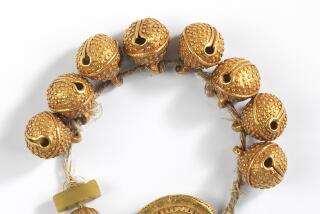King Tut’s Treasure Dazzled the World
- Share via
In a decade of sensations, it was perhaps the most spectacular sensation of all, a secret hidden from human eyes for three and a half millenniums: the lavish tomb of an ancient Egyptian pharaoh whose name would become a household word the world over.
Tutankhamen--”King Tut”--was barely 20 when he died after a brief reign, but ever since the world learned of his staggering trove of funereal riches in the Valley of the Tombs of Kings, his name has eclipsed all other Egyptian rulers’ in popular imagination save Cleopatra’s.
The stupendous 1922 find, the only intact Egyptian royal tomb ever discovered, resonates to this day. The discovery cemented archeology as scholarship as well as adventure.
More than 50 years later, when a few dozen tomb treasures toured the U.S., millions waited in line to gaze upon them. The “Tut” legend is so durable that decades after the tomb was opened, a comedian named Steve Martin could base a skit on Tut, with no explanation necessary.
The tale of search and discovery by Egyptologist Howard Carter held the world enthralled: his long, empty-handed years, the tantalizing clues and false leads, finally the discovery of a single limestone step, then the sealed doors, and at last the glittering inner sanctum.
On the November afternoon that Carter and his patron, the Earl of Carnarvon, finally stood before the door bearing Tutankhamen’s unbroken seals, their hands trembled; Carter opened a hole and beheld by candlelight the treasures placed there a million midnights before.
“Well, what is it?” demanded Carnarvon. “Yes,” responded Carter, “wonderful things.”
Thousands of golden and alabaster and bejeweled objects--any one of them priceless as treasure, as art, as artifact--filled the storehouse for the pharaoh’s afterlife.
It was months before Carter’s team worked its way through it all, to the sarcophagus itself. Touchingly, a faded funeral wreath of cornflowers and blue lotus still lay atop the first of Tutankhamen’s three nesting coffins, the innermost of them wrought from more than a ton of gold, with a death mask as enigmatically exquisite as Mona Lisa’s smile.
Thanks to the swift new media of newsreels and radio, “Tutmania” swept the globe, with Tutankhamen music, bathing suits, walking sticks, hats, flower seeds, cigarettes, haircuts, bracelets. The vogue for things Egyptian reached Hollywood, where the mummy horror film still thrives.
Then there was the lurid legend of the Tut Curse, the purported price for disturbing the exalted dead. After Carter’s pet canary was killed by a cobra, and Carnarvon died of a septic insect bite a few months later--the lights of Cairo flickered and went out at the same instant--there was no stopping the speculation.
*
But the knowledge gleaned from the find constituted an encyclopedia’s worth of Egyptiana. Amateur enthusiasts and gentleman archeologists had been plundering Egypt willy-nilly for centuries; Napoleon I, whose soldiers shot off the nose of the Sphinx, brought back an obelisk from his conquests.
By 1900, the storytelling skills of Heinrich Schliemann, who unearthed the fabled city of Troy, and the rigorous Egyptology of British archeologist Flinders Petrie had helped to popularize archeology, and also to professionalize it. The very completeness of the Tut find lent itself to studies on every aspect: religious, radiological, technological and, eventually, DNA.
The find also presaged treaty disputes and lawsuits over just who owns unearthed treasures, the discoverer or the land of discovery. (The Tut collection stayed in Cairo and, in an ugly coda, the Englishman Carter--who had wanted the treasure to remain in Egypt--was banned from ever reentering the tomb, a victim of a new sense of outraged nationalism.)
Yet Tut’s tomb yielded no treasure of another sort, papyrus--nothing to shed light on this 18th Dynasty pharaoh. His mother-in-law had been the eternal beauty Nefertiti, his father-in-law the pharaoh Akhenaton, who scandalized Egypt by trying to obliterate the old gods and introduce an early monotheism.
Egyptologists have long mused that if such riches accompanied a minor king, what must have been amassed for the likes of the great Ramses II, reputedly the pharaoh of the Jews’ captivity? Yet others speculate that those who buried Tutankhamen so grandly did so in gratitude for his undoing his father-in-law’s heretical legacy and restoring to them the familiar old gods, whose forms are so richly depicted surrounding the dead boy-king who sought life eternal among them.
More to Read
The biggest entertainment stories
Get our big stories about Hollywood, film, television, music, arts, culture and more right in your inbox as soon as they publish.
You may occasionally receive promotional content from the Los Angeles Times.











